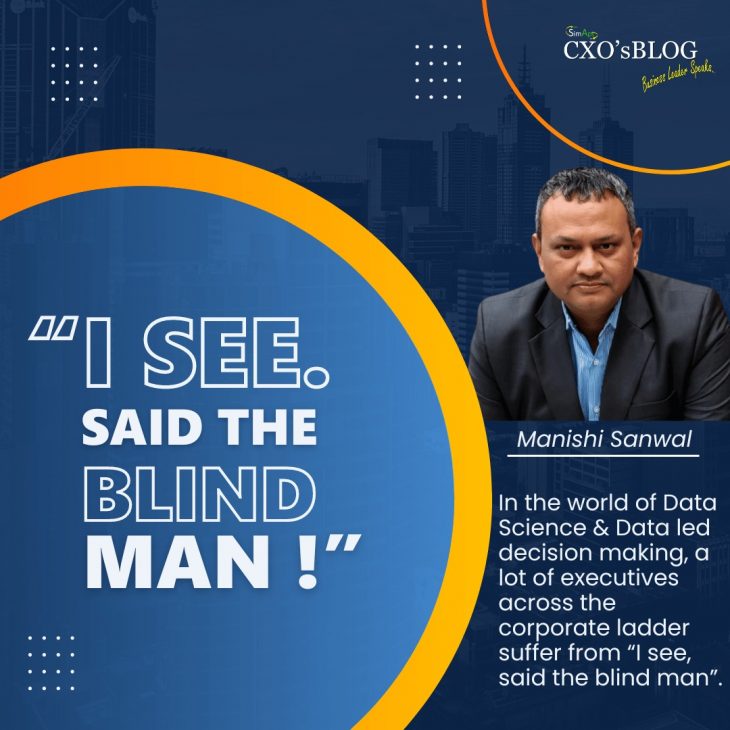Author: Manishi Sanwal
In the world of Data Science & Data led decision making, a lot of executives across the corporate ladder suffer from “I see, said the blind man”. “We do enough & we know enough” is a resonating statement across corporates and teams. In reality, a very few organizations have a holistic understanding of their data, the science of data analytics, available technologies to analyze & use it to enhance business decision making.
Running a data driven operation was simpler ten years back. There was limited data available and there were limited data analytics options available. It was easy to grasp few simple tables and charts at the end of a quarter and plan a strategy around that. The mathematics and science of data analytics has not changed over the years but the amount of data available as well as the increased computing power has crowded us with choices & options.
Today, Data analytics has a become buzz word for industry. Many age old & proven statistical techniques of Regression, Correlation, Analysis of Variation, Clustering are now being combined with new algorithms of forecasting & Decision tree systems to mine data for trends and causalities. Recency Frequency grids, Market Basket analytics, sequential pattern mining, decomposition of trends, sentiment analytics, web analytics and many more algorithms are being used along with Artificial Intelligence and Machine Learning to deliver a very different view of the data.
This sudden advent of new age technologies has split many companies into two diverse groups of operating managers (who understand the business problem but don’t understand the new age analytics) and a young analytics team (who understand the new age analytics tools but don’t understand the business problems). Further, the world of data analytics is a fast paced world with continuous new improvements being pushed by multiple developers and corporates around the world. This necessitates a continuous learning by any professional. One needs to stay in touch with new arrivals of algorithms else you risk being obsolete.
Data as an “NPA – the non Performing Asset”
Most companies have digitized certain parts of their processes. Almost all companies have hybrid systems where some processes are running in modern platforms along with few processes running in old heritage systems. The data is usually scattered across departments, people, old ERP, New ERP etc. etc. Most companies will struggle to produce a coherent complete set of data at first instance. Many times, incorrect or wrong or incomplete data is being collected which is either of no use or sub optimal use. Organizations are unable to differentiate between confidential & non confidential or between personal & non personal data and tend to hold almost all of it. They are unable to mine the data themselves and are reluctant to share it with outsiders leading it to be become NPA – the Non Performing Asset.
“In God we trust, everyone else, please get data”
The above requires a one-time clean up and one-time presentation of opportunities or one-time assistance of data led decision making. It requires creating new and correct KPIs for business objectives & subsequent revision KPIs when business objectives change or evolve. Once you have adopted and seen the benefits, it’s important to create a culture of data driven decision making. The transformation however is not complete unless its coded into the DNA of the company.
The culture of Data driven decision making is the mythical land of gold being looked for by many and found by few. A younger executive who understands the technology should invest his time and resources to understand the real life business problem. Business Problems in real life could be very different simply because of being abstract. Real life would never give you all the data inputs in the right format leaving you to have estimations and assumptions. Real life almost always would have multiple constraints emanating from departments like finance, purchase, HR, IT etc. To be successful, one needs to to create a coherence of objectives between those who understand data & analytics but don’t understand the business & its challenges and those who understand the business but don’t understand the modern-day analytics.
The Constraints of Data
The algorithms, software and the hardware have improved dramatically over the past few years. These combined with increased amount of data have created a possibility of models which are more precise and result oriented. The data, however will tell you some things but it won’t tell you many other things . Data analytics is a tool which will only assist human decision making. You cannot expect data or data analytics to solve your problems for you. They are of assistive nature & would improve your decision making. They won’t take the decisions for you.
